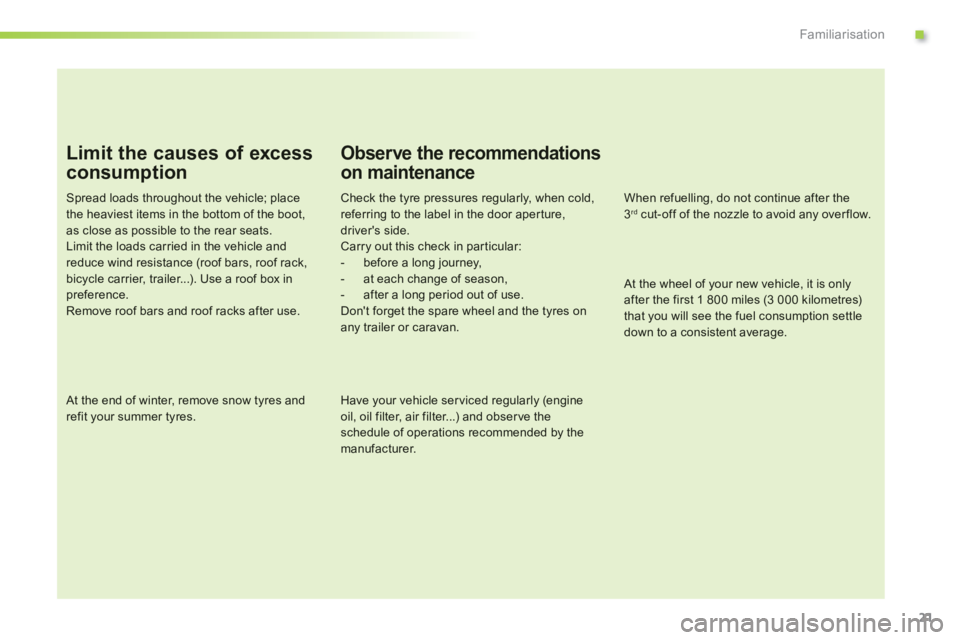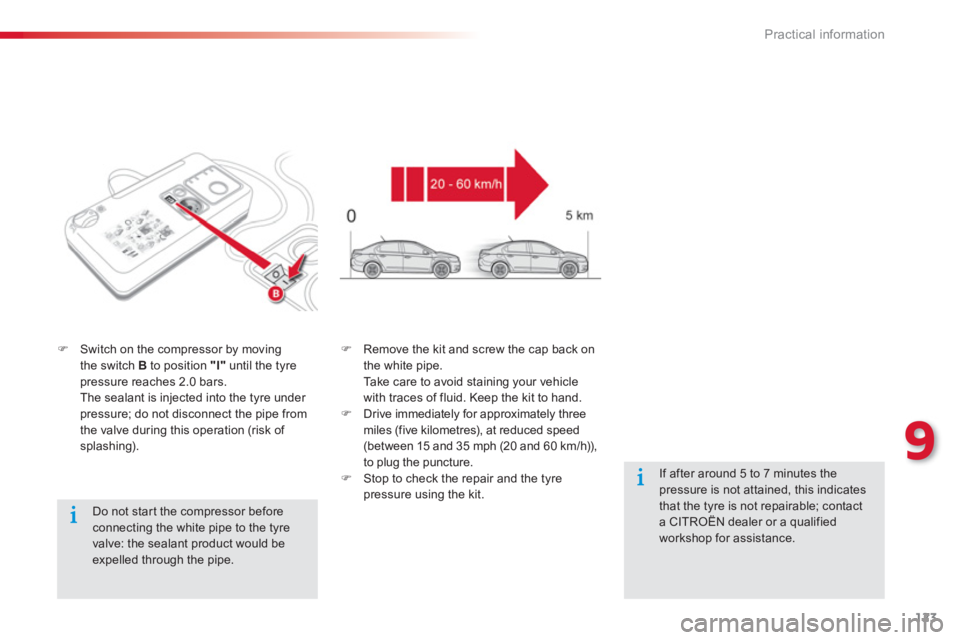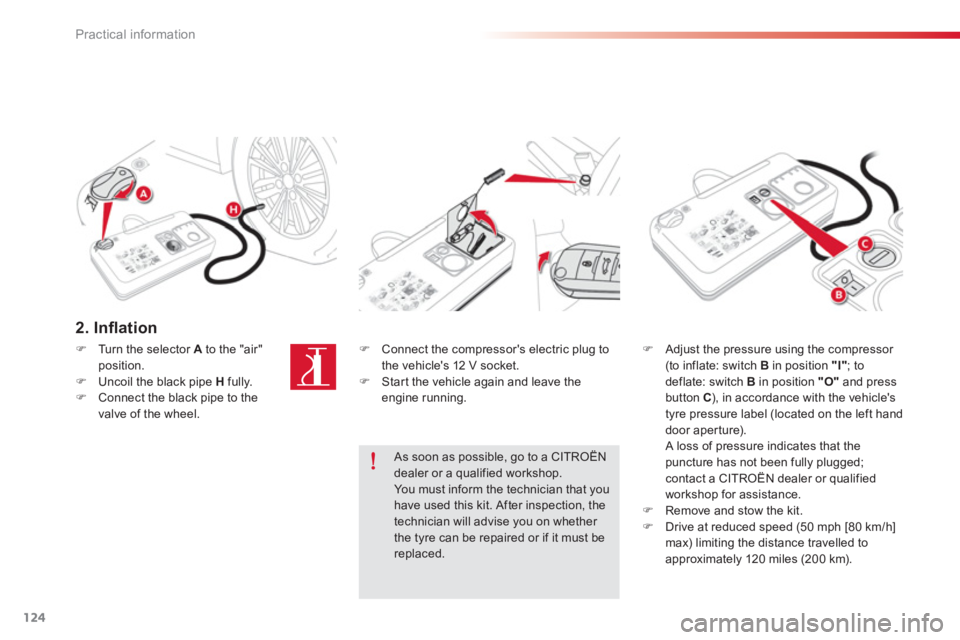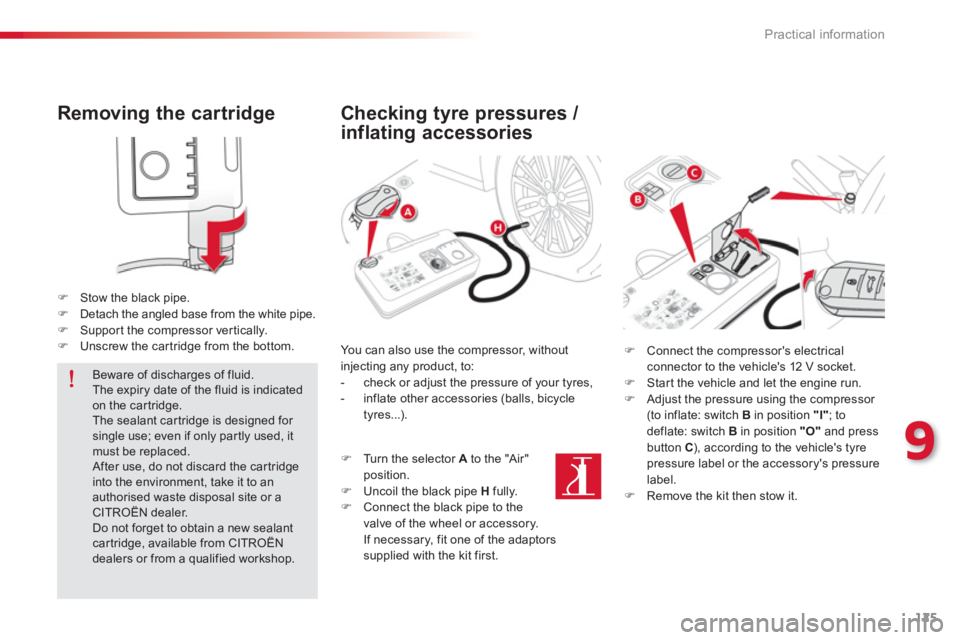tyre pressure CITROEN C-ELYSÉE 2014 Handbook (in English)
[x] Cancel search | Manufacturer: CITROEN, Model Year: 2014, Model line: C-ELYSÉE, Model: CITROEN C-ELYSÉE 2014Pages: 257, PDF Size: 9.06 MB
Page 23 of 257

.
21
Familiarisation
Limit the causes of excess
consumption
Spread loads throughout the vehicle; placethe heaviest items in the bottom of the boot,as close as possible to the rear seats.Limit the loads carried in the vehicle and reduce wind resistance (roof bars, roof rack, bicycle carrier, trailer...). Use a roof box inpreference.Remove roof bars and roof racks after use.
At the end of winter, remove snow tyres and refit your summer tyres.
Observe the recommendations
on maintenance
Check the tyre pressures regularly, when cold, referring to the label in the door aper ture, driver's side.Carry out this check in par ticular:- before a long journey,- at each change of season,- after a long period out of use. Don't forget the spare wheel and the tyres onany trailer or caravan.
Have your vehicle ser viced regularly (engine oil, oil filter, air filter...) and obser ve the
schedule of operations recommended by themanufacturer.
When refuelling, do not continue after the3 rd
cut-off of the nozzle to avoid any over flow.
At the wheel of your new vehicle, it is only after the first 1 800 miles (3 000 kilometres) that you will see the fuel consumption settledown to a consistent average.
Page 103 of 257

101
7
Safety
Group of supplementary systems which helpyou to obtain optimum braking in completesafety in emergency situations:
- anti-lock brakin
g system (ABS),
- electronic brake force distribution (EBFD),
- emergency braking assistance (EBA).
Braking assistance systems
Anti-lock braking system
and electronic brake force
distribution
Linked systems which improve the stability andmanoeuvrability of your vehicle when braking,
in par ticular on poor or slippery surfaces.
Activation
The anti-lock braking system comes into
operation automatically when there is a risk of
wheel lock.
Normal operation of the ABS may make itself felt by slight vibration of the brake pedal.
Operating fault
Emergency braking assistance
System which, in an emergency, enables you
to obtain the optimum braking pressure more
quickly, thus reducing the stopping distance.
When braking in an emergency, press firmly without releasing the pressure.
When braking in an emergency, press very firmly without releasing thepressure.
When replacing wheels (tyres andrims), ensure that they conform to the manufacturer's recommendations. I
f this warning lamp comes on,
accompanied by an audible signaland a message in the screen, it indicates a malfunction of the anti-lock braking
system which could result in loss of control of
the vehicle when braking.
I
f this warning lamp comes on,
together with the STOP
and ABSwarning lamps, accompanied by anaudible signal and a message in the screen, it indicates a malfunction of the electronic brake
force distribution which could result in loss of control of the vehicle when braking.
You must stop as soon as it is safe to do so.In either case, contact a CITROËN dealer or aqualified workshop.
Activation
It is triggered by the speed at which the brake pedal is pressed.
The effect of this is a reduction in theresistance of the pedal and an increase in
braking efficiency.
Coasting with the engine off results in aloss of power assistance for braking.
Page 122 of 257

120
Practical information
boot floor. Complete s
ystem consisting of a compressor and a sealant car tridge which permits
temporary repair of a tyre so that you can rdrive to the nearest garage.It is designed to repair most punctures which could affect the tyre, located on the tyre tread or shoulder.
Temporary puncture repair kit
Access to the kit
List of tools
All of these tools are specific to your vehicle
and can vary according to equipment. Do not
use them for other purposes.
1.12 V compressor.
Contains a sealant cartridge for the
temporary repair of a tyre and can also be used for adjusting tyre pressures.
2. Removable towing eye.
See "Towing the vehicle".
Page 123 of 257

121
9
Practical information
A."Sealant" or "Air" position selector.
B.On "I"/ off "O"switch. C.Deflation button.D.Pressure gauge (in bar or p.s.i.). E.
Compartment housing:
- a cable with adaptor for 12 V socket,
- various inflation adaptors for accessories, such as balls, bicycle
tyres...
Description of the kit
F.
Sealant car tridge.G.
White pipe with cap for repair. H.Black pipe for inflation.I.Speed limit sticker.
The speed limit sticker I
must be affixedto the vehicle's steering wheel to remind you that a wheel is in temporary use.
Do not exceed a speed of 50 mph(80 km/h) when driving with a tyre repaired using this type of kit.
Page 125 of 257

123
9
Practical information
Do not star t the compressor before connecting the white pipe to the tyre
valve: the sealant product would be expelled through the pipe.
�)Switch on the compressor by moving
the switch B to position "I"until the tyre pressure reaches 2.0 bars.
The sealant is injected into the tyre under pressure; do not disconnect the pipe from
the valve during this operation (risk of splashing).
�) Remove the kit and screw the cap back on
the white pipe.
Take care to avoid staining your vehicle
with traces o
f fluid. Keep the kit to hand. �) Drive immediately for approximately three
miles (five kilometres), at reduced speed(between 15 and 35 mph (20 and 60 km/h)),
to plug the puncture. �) Stop to check the repair and the tyre
pressure using the kit.
If after around 5 to 7 minutes the pressure is not attained, this indicates that the tyre is not repairable; contacta CITROËN dealer or a qualifiedworkshop for assistance.
Page 126 of 257

124
Practical information
2. Infl ation
�)
Connect the compressor's electric plug to
the vehicle's 12 V socket.�) Star t the vehicle again and leave the engine running.
�)Adjust the pressure using the compressor (to inflate: switch B
in position "I"
; to deflate: switch B
in position "O"and press button C), in accordance with the vehicle's
tyre pressure label (located on the left hand
door aperture).
A loss of pressure indicates that the
puncture has not been fully plugged; contact a CITROËN dealer or qualified
workshop for assistance.�)Remove and stow the kit.�)Drive at reduced speed (50 mph [80 km/h]
max) limiting the distance travelled toapproximately 120 miles (200 km).
As soon as possible, go to a CITROËNdealer or a qualified workshop.You must inform the technician that you have used this kit. After inspection, the technician will advise you on whether
the tyre can be repaired or if it must be replaced.
�)Turn the selector Ato the "air" position.�)Uncoil the black pipe Hfully. �)Connect the black pipe to the
valve of the wheel.
Page 127 of 257

125
9
Practical information
Removing the cartridge
�)Stow the black pipe. �)Detach the angled base from the white pipe.�)Suppor t the compressor ver tically.�)Unscrew the car tridge from the bottom.
Beware of discharges of fluid.
The expiry date of the fluid is indicated on the car tridge.
The sealant car tridge is designed for single use; even if only partly used, itmust be replaced. After use, do not discard the car tridgeinto the environment, take it to an authorised waste disposal site or a CITROËN dealer.
Do not forget to obtain a new sealantcartridge, available from CITROËN dealers or from a qualified workshop.
Checking tyre pressures /
inflating accessories
You can also use the compressor, withoutinjecting any product, to:
- check or adjust the pressure of your tyres,
- inflate other accessories (balls, bicycle
tyres...).
�)
Turn the selector Ato the "Air"
position.
�) Uncoil the black pipe H
fully.�)
Connect the black pipe to the
valve of the wheel or accessory.
If necessary, fit one of the adaptorssupplied with the kit first.
�) Connect the compressor's electrical connector to the vehicle's 12 V socket. �)
Star t the vehicle and let the engine run. �)
Adjust the pressure using the compressor (to inflate: switch B
in position "I"
; to deflate: switch B
in position "O"and press button C), according to the vehicle's tyrepressure label or the accessory's pressure
label. �) Remove the kit then stow it.
Page 154 of 257

152
Practical information
Driving advice
Distribution of loads
�)Distribute the load in the trailer so that theheaviest items are as close as possible to
the axle and the nose weight approaches the maximum permitted without exceeding it.
Air density decreases with altitude,
thus reducing engine performance. Above 1 000 metres, the maximum towed
load must be reduced by 10 % for every
1 000 metres of altitude.
Side wind
�)Take into account the increased sensitivity
to side wind.
Cooling
To w i ng a trailer on a slope increases the
temperature of the coolant.
As the fan is electricall
y controlled, its cooling capacity is not dependent on the engine speed.
�)
To lower the engine speed, reduce your speed.
The maximum towed load on a long incline
depends on the
gradient and the ambient
temperature.
In all cases, keep a check on the coolant
temperature.
�)If the warning lamp and the
STOP warning lamp come on, stop the vehicle and switch off
the engine as soon as possible.
Braking
To w i ng a trailer increases the braking distance.
To avoid overheating of the brakes on a longmountain type of descent, the use of engine braking is recommended.
Tyres
�)Check the tyre pressures of the towingvehicle and of the trailer, obser ving the recommended pressures.
Lighting
�)Check the electrical lighting and signalling on the trailer.
The rear parking sensors will be deactivated automatically if a genuine CITROËN towbar is used.
R
efer to the "Technical Data" section for details
of the weights and towed loads which apply to your vehicle.
Page 175 of 257

173
11
Technical data
Identifi cation markings
A.Vehicle identification number (VIN)under the bonnet.
This number is engraved on the bodyworknear the passenger compartment filter.
The tyre pressures must be checked when the tyres are cold, at least oncea month.
Low tyre pressures introduces the riskof a burst tyre and also increase fuel consumption.
B.Vehicle identification number on thedashboard. This number is indicated on a self-adhesive label which is visible through the
windscreen.
C.Manufacturer's label.The VIN is indicated on a self-destroying
label affixed to the lower right hand centre
pillar.
D.Tyre/paint label.This label is affixed to the driver's side centre pillar. It bears the
following information:
- the tyre pressures, for unladen and laden
conditions,
- the tyre sizes,
- the spare t
yre inflation pressure,
- the paint colour code.
Various visible markin
gs for the identification of your vehicle.
Page 224 of 257

222
Visual search
Exterior
Remote control key 42- 45 - opening / closing- anti-theft protection- starting- battery
Boot 49-50 - opening / closing- emergency releaseTemporary puncture repair kit 120 -125
Wipers 97-98
Changing a wiper blade 148
Changing bulbs 137-13 8 - rear lamps - 3rdbrake lamp- number plate lamps- foglamp
Fuel tank, misfuel prevention 52-54
Accessories 154-157
ESP/ASR 102
Tyre pressures 173 Changing a wheel 126 -132
- tools
- removing / refitting
Lighting controls 91-95 Daytime running lamps 95 Headlamp beam adjustment 96 Changing bulbs 133 -136 - front lamps- foglamps - direction indicator repeaters To w i ng 149 -15 0 Very cold climate screen(s) 15 3
Door mirrors 58-59
Doors 42- 45, 48 - opening / closing- central locking - secondary control Alarm 46-47 Electric windows 51
Rear parking sensors 89 -90
To w b a r 151